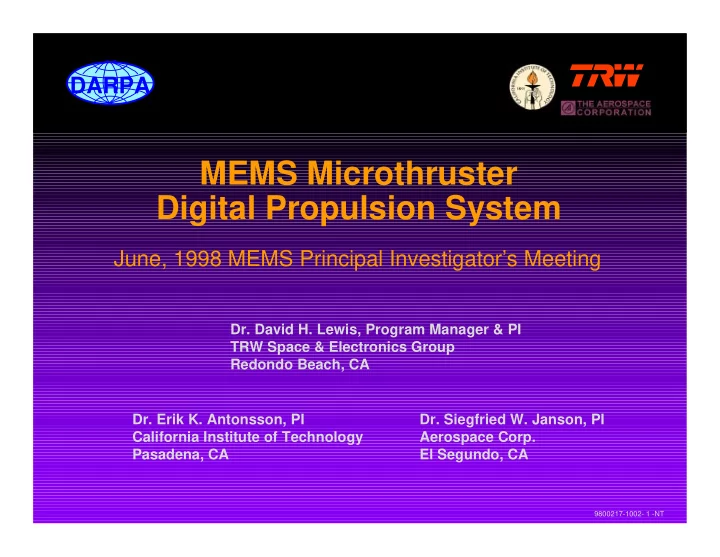

DARPA ��� MEMS Microthruster Digital Propulsion System June, 1998 MEMS Principal Investigator’s Meeting Dr. David H. Lewis, Program Manager & PI TRW Space & Electronics Group Redondo Beach, CA Dr. Erik K. Antonsson, PI Dr. Siegfried W. Janson, PI California Institute of Technology Aerospace Corp. Pasadena, CA El Segundo, CA 9800217-1002- 1 -NT
MEMS Technologies Support DARPA ��� Future Space Systems • Distributed proliferated systems have multiple applications – Large apperture – Long baseline – Communication – Interceptors • Low mass nanosats combined with MEMS Digital Propulsion has system advantages – Several MEMS Digital Propusion Concept Sketch of Microsatellite Constellation implementations can be identified 6 Deliverable delta V (km/s) M final I sp =1000 - ² V/I sp g 0 =e 5 M initial • I sp :<250 sec, resistojet 4 • I sp :<250-300 sec, solid propellant 400 3 • I sp :300 + -450 sec, bi-propellant 300 2 200 • I sp :1,000 + sec, PPT’s 1 100 50 – Efficient packaging - no valves, lines or 0 0 0.2 0.4 0.6 0.8 1 structure Propellant Mass Fraction Interceptor ²V Increase Improves as I sp Increases 9800217-1002- 2 -NT
Exploded View of Digital DARPA ��� Microthruster Array Diaphragms on bottom, Top Die expansion nozzles on top Middle Die Propellant fills individual holes Polysilicon “ignitors” with direct inter- Bottom Die connects to bond pads (no electronics) 9800217-1002- 3 -NT
Top View of Phase 1 DARPA ��� Thruster Stack 6 mm square Bond pads 400-micron Alignment thick top wafer Holes 15 thrusters in a 3 x 5 array 9800217-1002- 4 -NT
Assembled Phase 1 DARPA ��� “Thruster Chip” 9800217-1002- 5 -NT
DARPA ��� Fabrication Issues • Combustible solid: – Ignitor design; 20 x 400 µ resistors required for lead styphnate – Resistors must be thermally-isolated from substrate yet be mechanically robust – Bonds must withstand high transient pressure • Resistojet: – No inter-chamber leaks – Bonds must withstand ~ 600 K temperature • Electrolysis rocket: – No inter-chamber leaks 9800217-1002- 6 -NT
DARPA ��� Fabrication Issues • Nozzle array: – Mechanical dicing requires diaphragm protection • Propellant die: – Planarity of baked FOTURAN – CTE mismatch to silicon; bonding agent required – Filling die with propellant; use solids if possible • Electronics die: – Thermal isolation of resistors using standard CMOS SiO 2 layer thickness; reduce power requirements – High voltage (>100 V) for spark generation • Bonding die: – Cyanoacrylate cannot tolerate high temperatures – Epoxies require controlled deposition (screen printing) 9800217-1002- 7 -NT
Laser Exposure of Glass DARPA ��� Spacer Dice Individual die separate during the HF etch 9800217-1002- 8 -NT
DARPA ��� 20 x 400 Resistor 46 MICRONS Polysilicon 0.5 micron thick 29 41 MICRONS MICRONS 22 MICRONS Gold 0.5 100 MICRONS 120 MICRONS 188 MICRONS micron thick 41 29 32 MICRONS MICRONS MICRONS 180 MICRONS 20 MICRONS 180 MICRONS 46 MICRONS The polysilicon heater element is 20 microns wide, 0.5 microns thick, and has a resistance of 210 Ohms. We apply 30 Volts and it glows red. 3 m SiO 2 SILICON SUBSTRATE 9800217-1002- 9 -NT
High Speed Video Images of DARPA ��� Polysilicon Resistor Firing t = 0 msec t = 25 msec t = 49 msec t = 74 msec t = 98 msec t = 123 msec t = 148 msec t = 173 msec • With 60 volts input, the 20 x 400 resistor fires for ~50 msec 9800217-1002- 10 -NT
DARPA ��� Thrust Stand • Ballistic pendulum thrust stand of 240 gram mass • Impulse range: 10 -6 to 10 -3 N-s • Laser interferometric position measurement • Active magnetic damping • Basic Stamp microcontroller • In-vacuum calibration 9800217-1002- 11 -NT
DARPA ��� Videotapes • Resistor glow • Ignition of thin propellant layers – Nitrocellulose using kilovolt AC in resistors – Lead styphnate using 32 V DC in resistor • Electrolysis • Solid thruster ignition • Thrust stand firing 9800217-1002- 12 -NT
DARPA ��� Summary • Combustible solid, resistojet, and electrolysis microthrusters demonstrated – All three viable with specific propellants • Initial problems: – Poor ignition of typical solid propellants – Weak bond strength at high temperatures – Inter-chamber leaks for glue-bonded layers • Thrust stand is ready – Customize power drivers for different power requirements (solid, resistojet, electrolysis) 9800217-1002- 13 -NT
Digital Propulsion Concept is DARPA ��� Refined Through Three Hardware Builds Task 5. MEMS Microthruster Propulsion System • Management • Reporting We Are Here Task 1. Proof of Concept 3 Downselect Configurations • Design • Test • Fab • Characterize Task 2. Sub-Array Evaluations Downselect 2 Test Articles • Design • Test Task 3. Full-Array Demonstration • Fab • Characterize 1 Test Articles • Design • Test • Fab • Characterize • Commercial foundry builds Task 4. Process Models and Analyses 9800217-1002- 14 -NT
Recommend
More recommend